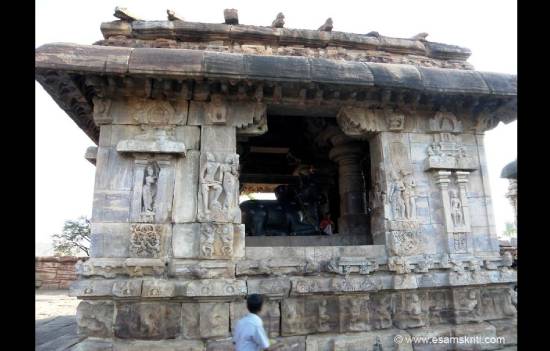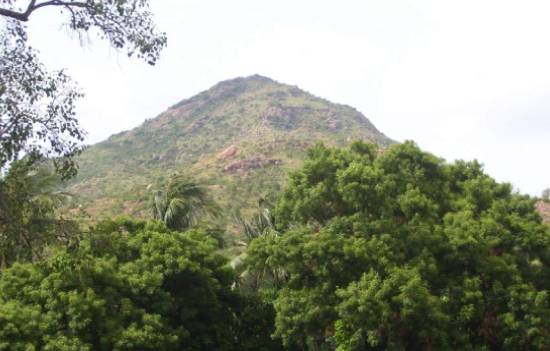- What is the meaning of Siva Linga? How distorted interpretation of Sanskrit words lead to wrong conclusions. Nandi narrates the two modes of worship of Siva. Know the deeper meaning behind worship of Sivalinga and Swami Vivekananda’s views too.
In every Siva temple Nandi sits facing the Sivalinga. The tradition is that devotees whisper their wishes in Nandi’s ear, who tells Siva after His meditation is over.
The story behind this custom is that when
Devas and Asuras churned the ocean, one of the first things to emerge was Halahala-a very deadly poison. Deciding to remove the agony of the world, Mahadeva took the widespread poison in His hand and drank it. Vishnu gave a boon that the halahala will never come out of His throat and Shakti pressed below Siva’s throat where the halahala was located. Hence he was called Neelakantha
(blue-throated one) and Vishakantha (poison-throated one). The effect of poison was so painful that Siva couldn’t meditate, so Nandi was asked to sit in front of Siva and blow air on the throat to cool him from the burning sensation. Since then Siva meditates with help of Nandi. Devotees do not go between Nandi and Sivalinga as it will disturb Siva’s meditation.
 Nandi facing Brihadesvara Shiv Mandir, Thanjavur.
Nandi facing Brihadesvara Shiv Mandir, Thanjavur.
Siva Linga is composed of two Sanskrit words - Siva and Linga. Siva denotes ‘Form of Siva’ and Linga denotes ‘symbol’. Siva Linga means symbol of Siva. Linga has two meanings - phallus and symbol. In Siva Linga, the meaning of Linga is symbol. Linga symbolizes the creative and destructive power of Siva. In Hindi, Marathi, Bangla ‘Linga’ stands for Gender while in Sanskrit 'Linga' is a sign or symbol. It is highly unfortunate that those who were not well versed in
Sanskrit translated our scriptures and translated Linga as phallus, male organ
to demean Siva and made Sivalinga puja look obscene.
Sanskrit words are loaded with meanings.
This is evident from the fact that a scripture has been so composed that it can
be read in two different ways. This is possible due to multiple meanings of
words and sandhis, i.e. compounds. An example of this is the composition of an entire
scripture that can be read in two different ways - the Raghava-paṇdaviya, which can be read as the Ramayaṇa one way, and
the Mahabharata in other way, when each verse is interpreted differently. Such
a piece of literature is called the dvisandhaana
kaavya.
Similarly, Koti has two meanings-type and crores. 33 koti devatas meant to be
33 types of devas, or 33 characteristics of devas, and not 33 crore devas. Even
subhashitas can be interpreted wrongly.
Shankaram patitam drushtwa,
parvati harshnirbharah; rudanti pannagah sarve, Ha Ha Shankar Shankar.
The wrong interpretation is, ‘Seeing that Shankara (Mahadeva) has fallen down, Parvati (wife of Mahadeva) became happy, and all the snakes around His neck started crying Oh! Shankara has fallen down’. The actual meaning is, ‘seeing that Shankar (a sandalwood tree) has fallen down Parvati (a lady residing in mountains) became happy (as she can now use sandalwood), and all the snakes (living on the Sandalwood trunk) started crying, Oh! Our tree has fallen down.
In another sloka, Keshavam patitam drushtwa, pandvaha harshnibharah; rudanti kauravah sarve, Ha Ha Keshav Keshav.
The wrong interpretation is, ‘Seeing that Keshava (Krishna) has fallen down the Pandavas became happy, and Kauravas started crying Oh! Lord Krishna has fallen down. The actual meaning is, ‘Seeing that Keshava (some corpse) has fallen down, Pandavas (other meaning of Pandavas is Fishes) became very happy and Kauravah (Crows, kau iti ravam karoti te) started crying oh some corpse has fallen down (in water).
Puranas recite
the episode of Sanata kumara, the eternal
five year old first son of Brahma, approaching Nandikeshwara to learn about Siva.
 At Pattadakal, Karnataka opposite the Virupaksha Mandir is the Nandimantapa.
At Pattadakal, Karnataka opposite the Virupaksha Mandir is the Nandimantapa.
Nandi narrates how in the beginning of
Kalpa, Brahma and Vishnu debated with each other to find out who out of them is
the Supreme God. Mahadeva appeared in
between them in his nirguna, attribute-less form of (Skambha) of jwala
(fire). It was an infinite column of
fire (of consciousness). A voice was heard from the flame that the one who
could find the top or bottom of the pillar of light would be considered the
greater. Taking the form of a boar, Vishnu dug deep into the earth in search of
the bottom while Brahma, as a swan, flew upwards. Centuries passed until
Vishnu, halting deep in earth meditated and realized that the limitless pillar
of light was the Source of Liberation, the light of Awareness that transcended
Time and Space.
Brahma, who had flown above, beyond stars
took hold of a flower that was falling down and presenting it to Siva, claimed
to have retrieved it from top of the light. Seeing through this deceit, Siva
announced that Brahma would have no temples as he had not got rid of his ego.
Vishnu and Brahma pleaded with Mahadeva to cool His fierce brightness so that
celestial and earthly beings could worship Him and their darkness of illusion
would be removed. Siva allowed the Light to cool, which in successive yugas was
worshipped as a lingam of diamond (in Tretayuga), of gold (in Dwaparayuga) and
finally, a lingam of stone (in Kaliyuga).
Mahadeva’s radiating stambha became the symbol (Linga) which denotes Him as attribute-less Supreme Brahman.
On the request of Brahma and Vishnu, Siva
assumes His sakala aspect (with attributes). Nandi
narrates that the two modes of worship - worship of nirguna Sivalinga and worship of saguna idol grants bliss and liberation. Siva’s Skambha represents his Nirguna aspect and his visible form represents his Saguna aspect. Siva is absolute reality, transcendent, beyond Time and Space, beyond dvaita and advaita, beyond human comprehension. He is both - formless and with form. Forms are limited so Siva destroys forms and is worshipped as the linga.
Krishna tells Yudhishthira in Mahabharata
that the seers call Mahadeva as Agni and Sthanu and Maheshwara, the one who has three-eyes, and who is also
single-eyed, who is of a universal form, and who bestows auspiciousness, vadantyagni maadevaṁ tatha sthaṇu maheshvaram /ekakṣam
tryambakam chaiva vishvarupam shivaṁ tatha.
Maharishi Veda Vyas tells in Mahabharata to Ashwatthama, how Narayana who is called Kesava, worships Siva and Siva has great affection for Kesava. Vyasa mentions that Kesava (Vishnu) is that devoted worshipper of Rudra who has sprung from Rudra himself. Kesava always worships Siva, regarding his Linga emblem to be the origin of the universe. The God having the bull for his mark cherishes greater regard for Kesava’.
Seeing Siva’s infinite form of column of fire of consciousness, Yajurveda’s Taittiriya Aranyaka offers salutations to the Agni-Stambha, ‘jvalalingaaya namaḥ’ , ‘Salutations to Him, He, who has the form of the Agni Linga’ (Taittiriya Aranyaka 10:16:2). This pillar of fire had neither beginning nor end as stated in Skanda Purana, agnistambhamayam
roopam sambhoraadyanta varjitam.
This Jwala-Linga is termed as ‘Skambha’ in Atharva Veda. The entire creation is said to have sprung from this ‘Jwala-linga (Skambha)’ form of Mahadeva. In the 10th Adhyaya of Atharva Veda questions are asked, ‘What is the basis of everything? Who is doing all the changes in the world, births and deaths, constant transformation, continuous movement? What is the Source? What Force lies behind all this?’ The answer is given in (Atharva Veda Samhita-10,7.29), “skambhe lokaḥ skambhe tapaḥ skambhe 'dhy ṛtam ahitam, skambha tva veda pratyakṣam indre sarvaṃ samahitam.”
Skambha means fulcrum, the point at which a bar is balancing. Skambha is the fulcrum of Creation. ‘Skambha/ ‘Sthambha’ is the infinite pillar of fire of consciousness, which is Siva, the Supreme Brahman. The story of Siva’s first appearance in his Skambha form is documented in several Puranas – Shiva Purana, Linga Purana, Skanda Purana and Devi Bhagvata Mahapurana and even in Vayu Purana as the ‘infinite pillar of fire whose ends couldn’t be measured’. The very name, Linga Purana, is due to Siva’s infinite Jwala-Linga, the Agni Shikha, a vertical column of light (of Consciousness), the Sivalinga.
When Swami Vivekananda was invited by the
Paris Congress, a German scholar Mr. Gustav Oppert, read a paper on the origin
of Siva-Linga as the phallic emblem of the male and Shalagrama of the female
generative principle. He tried to establish that the worship of Siva Linga and
Shalagrama are the component parts of worship of Linga and Yoni. Swami
Vivekananda immediately repudiated the theory quoting the famous hymn of
Atharva-Veda Samhita. In Linga Purana,
the same hymn is expanded in shape of stories meant to establish the glory of
the great Stambha and the superiority of Mahadeva.
 Arunachal Hill. Pic by Vijay Anand.
Arunachal Hill. Pic by Vijay Anand.
Swami Vivekananda explained that words like ‘Shraddha’ cannot be translated into English due to limitation of English language. Karma, Ishvara, Deva, Bhagavan, Akasha, Linga
cannot be translated. Ishvara, deva,
Bhagavan is interpreted as God and confusion begins. Missionary scholars translated the word linga as physical organ and coming generations were brainwashed into feeling ashamed of worshipping Sivalinga. The most common Sanskrit word used for the generative organ in Sanskrit scriptures is shishna or shepha and not linga. If Sanatana Dharma wanted masses to worship the phallus symbol, they would have also used shishna etc as synonyms. Linga is pratika or chinha; symbol, emblem, indication of Ishvara, Skambha or Bhagavan Shiva.
Siva Lingas are chiefly divided into four types: Swayambhu,
Daivika, Arsha and Manusha. All are sacred. Swayambhu lingas or udbhuta lingas
occur naturally, as in Narmada River. Those given by devas, Bhagwan, deities
are called Daivika. Siva Lingas made by humans are called Manusha and those
which are of unknown origin are known as Arsha.
The top of the udbhuta or swayambhu linga is generally broader than the
base. The daivika linga has a drum-like shape and the maanusha linga can be of
equal shape. There is another classification of Sivalinga: nishkala, sakala and
mishra. Those which have no marks on them are nishkala lingas. Those which have
the form of Shiva are sakala. Mishra lingas have only face of Shiva.
The Agni-Linga of Siva manifested itself in the form of a mountain for the sake of devotees. That place is in Tiruvannamalai in Tamil Nadu called as ‘Arunachala Kshetra’ in Skanda Purana. Arunachala-Kshetra is called Agni-linga kshetram among the pancha-bhuta-linga kshetras of Siva. This is the mountain which attracted Bhagawan Sri Ramana Maharshi to itself.
In Skanda Purana’s ‘Arunachala Mahatmayam’, Siva proclaims, ‘The moment you set your eyes on It, your ignorance will be destroyed! Its glory gives sight to the blind, ability to walk to the lame, progeny to the childless and speech to the dumb. Arunachala confers all siddhis, cures all diseases, destroys all sins and grants all boons. Every year, during Kartigai, I shall appear on the summit of this Hill in the form of fire. Those who see that fire and meditate upon it, shall realise the great light within themselves.
The entire creation is said to have sprung
from this infinite pillar of fire, so when we worship Sivalinga, we worship the
Creation, the Fulcrum, the Source, the Foundation, the Father, the Basis of
this Universe. From no angle can a phallus appear from a pillar of fire, from
the foundation. There is no reason to be ashamed of worshipping the Sivalinga.
Worshipping Sivalinga is worshipping the Brahmaanda.
Author
is a contributor to Speaking Tree and eSamskriti for years. We value her high
quality articles.
To read all articles
by author
Also
read
Shivalinga
is a symbol of Shiva-Shakti Union